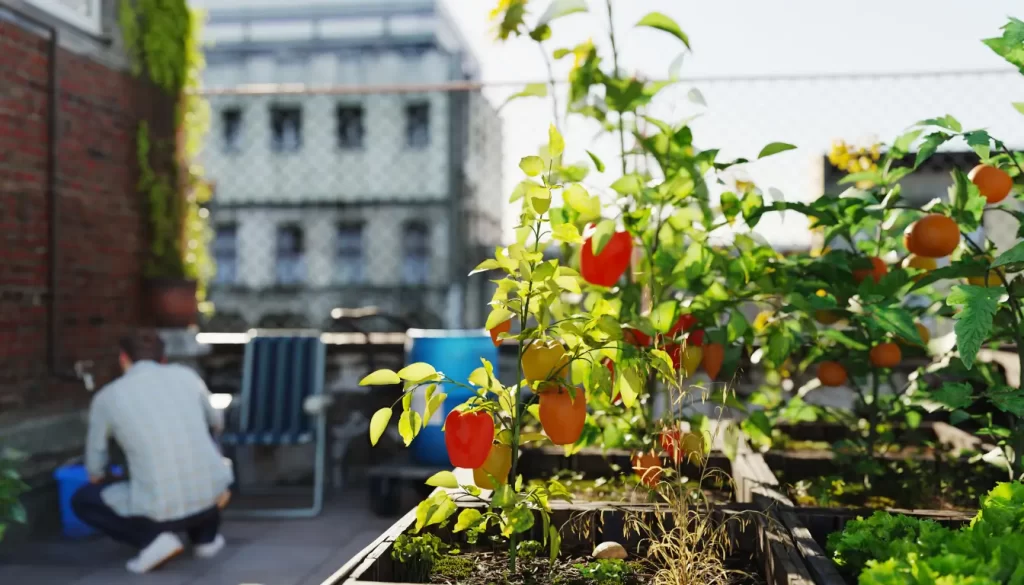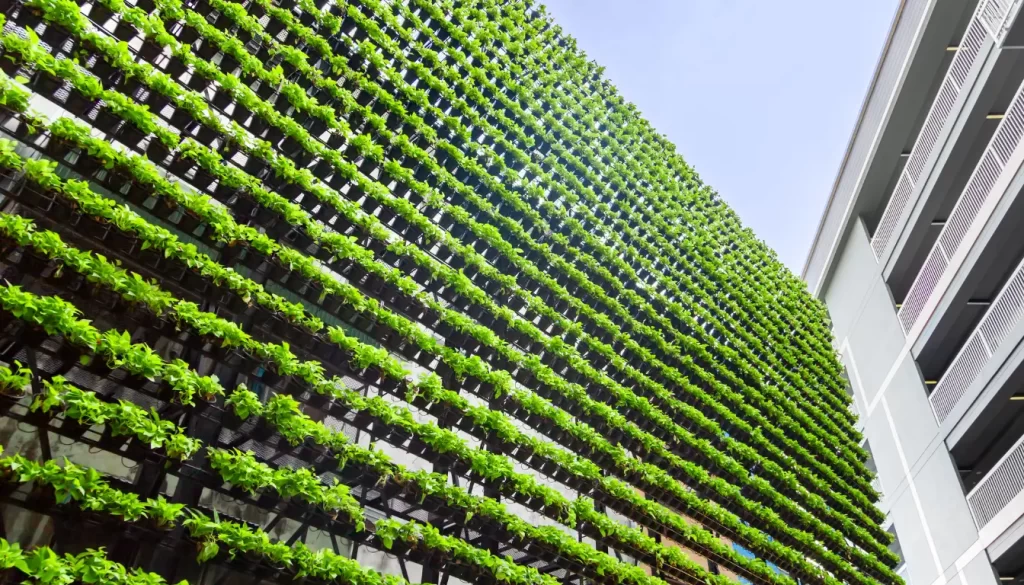Urban gardening is transforming cityscapes across the globe. Its rise in popularity is no accident, it’s a response to multiple, interconnected, compounding factors. These include growing concerns around environmental sustainability, bulging global populations, increasingly limited arable land, and the desire for local food sources.
So, what is urban gardening? In the most basic sense, it’s a type of small-scale farming that takes place in an urban area. You can create your own, or make it a community effort.
Around the world, populations in cities are increasingly using any space available—whether that’s a rooftop, a vacant lot, or even a balcony–to grow food. This represents a broader shift towards more responsible, community-oriented living, where the benefits extend beyond the individual urban gardener to the wider community and the environment. Below, we’ll unpack the nuances and explain key aspects of the rise of growing and harvesting food in concrete jungles.

Types of Urban Gardens
Urban farming can take many forms. You’d be surprised at how creative people are when it comes to finding space to cultivate.
Whether you’ve got a tiny apartment with just a sliver of sunlight or a bit more space to play with on a rooftop, there’s a way to get your hands dirty and grow something fresh.
It doesn’t have to look nice–that’s not the point. The goal is to transform even the smallest of spaces into productive, fertile soil. Below, we cover some of the many approaches you can use to create something out of nothing.
Community Gardens
Community gardens are collaborative projects in shared open spaces where individuals come together to cultivate flowers, vegetables, and fruits. Normally someone in the community spearheads the project. These gardens provide fresh produce and can foster a strong sense of community and connection with your neighbors.
PRO TIP: Before planting, engage in a discussion with fellow gardeners to plan the garden layout and plant selection. This collaborative approach ensures a diverse and harmonious garden that meets the community’s needs and preferences. Additionally, consider scheduling regular community workdays to maintain the garden and strengthen community bonds.

Vertical Gardens
Vertical gardens utilize vertical space to grow plants, making them perfect for urban environments where horizontal space is limited. By growing upwards on trellises, wall-mounted planters, or green walls, vertical gardens can turn any blank wall into a lush, green oasis.
PRO TIP: Set up a vertical garden with plants suited for sunlight exposure and growth habits. Vines, edible greens, and herbs are ideal choices. Create a sturdy structure with a reliable watering and drainage system to keep the garden flourishing.

Rooftop Gardens
Have a rooftop that’s not being used? Turn it into a rooftop garden. Take advantage of that unused flat surface area. Rooftop gardens transform the tops of buildings into productive green spaces. And they’re typically large in area, meaning you can grow on a large scale. But not every plant is happy on a rooftop.
PRO TIP: Be sure to check that the type of plants you want to grow can withstand constant sunlight. Most rooftops lack shade and get quite hot as the sun is absorbed by the building materials. Be sure to plan your crop according to these growing conditions.

Indoor Gardens
With the use of indoor planters, hydroponics, and even aeroponics, people can grow plants inside their homes or apartments. This type of gardening is particularly useful if you live in a place with long, cold winters.
PRO TIP: Lighting is crucial for indoor gardening success, especially during long, cold winters when natural sunlight is limited. Consider investing in grow lights to provide your plants with the necessary spectrum of light they need to photosynthesize and thrive. LED or fluorescent grow lights are energy-efficient options that can support a wide range of plants, from leafy greens to flowering fruits.
Window Box Gardens
Think you don’t have space for your own urban vegetable garden? Do you have a window in your apartment or house? If so, you can utilize window boxes as an easy way to grow. This approach is ideal for growing herbs.
PRO TIP: Drainage is key to preventing root rot and ensuring your window box garden flourishes. Make sure your window boxes have adequate drainage holes at the bottom. If not, drill some yourself, and consider lining the bottom with a layer of gravel before adding soil. This extra step will help keep your plants healthy by preventing excess water from pooling around the roots.

There are tons of types of urban gardens and we just scratched the surface above. Each type has its unique definition and purpose, but all share the common goal of integrating nature into urban settings. They turn underutilized spaces into productive, green areas that benefit your community and the environment.
The Rise of Urban Gardening
The story of urban gardening is as rich and varied as the cities it flourishes in. From its ancient roots in Mesopotamia to its modern resurgence, it has evolved significantly. (Check out this article to learn more about the history of urban farming.)
But what has propelled this evolution and formed what we know as urban farming today?
From Necessity to Trend
Initially born out of necessity in urban environments—where space was scarce and food security a constant concern—urban gardening has blossomed into a global movement. It’s driven by modern urbanites’ desire for green spaces, fresh produce, and a sustainable lifestyle.

Responding to Urban Challenges
The evolution of the urban gardener is marked by human ingenuity in adapting to city life’s limitations. Innovations such as vertical gardens and rooftop gardens are creative solutions that address urban challenges like limited space and the heat island effect. This highlights city gardening’s role in environmental sustainability.
A Green Social Movement
Beyond its environmental and health benefits, urban gardening has sprouted as a significant social movement. It encourages community engagement and collaboration around common goals.
Plus, community gardening supports mental and physical wellbeing. A study from the University of Colorado Boulder found that community gardening can lead to measurable physical and mental health benefits.
Participants in community gardens increased their fiber intake, engaged in more physical activity, and experienced reduced levels of stress and anxiety.

The Role of Policy and Advocacy
Progressive public policy and strong advocacy efforts have facilitated the proliferation of gardening in cities. Cities increasingly recognize the value of integrating green spaces into urban planning for public health, sustainability, and community resilience.
Urban farming also plays a critical role in our efforts to advocate for environmental sustainability. It encourages healthy and interconnected urban living and its growth is a testament to the collective drive to create greener, more sustainable urban environments.
Looking to the Future
Urban gardening is more than a trend; it’s a force for good in our cities. It reimagines urban living and redefines our relationship with the natural world. It’s a great example of the power of collective action and the potential of green spaces to contribute to environmental and social goals.
By turning underused urban areas into productive spaces, it helps urban development. Gardens are sources of local produce and spaces for community engagement, education, and biodiversity promotion.

Interested in getting started? Here are a few tips to get you off and rolling with urban gardening:
- Start Small: Begin with what you have. A windowsill, balcony, or small backyard can be the starting point of your gardening exploration.
- Engage with Your Community: Look for community gardening initiatives or start one yourself! Gardening with others can exponentially increase the benefits involved.
- Educate Yourself and Others: Attend workshops, online resources, and community programs to expand your knowledge and share it with your neighbors.
- Advocate for Green Spaces: Support local policies and initiatives that promote using urban spaces for gardening and the integration of green spaces into urban planning.
Looking ahead, the future of gardening in smart cities promises even more innovative approaches to integrating nature into our urban environments. As technology and traditional gardening practices merge, we can cultivate highly efficient, sustainable urban green spaces that feed our physical, mental, and emotional wellbeing.
Urban gardening can be the key to growing communities and making our cities livable for future generations. Whether you’re a seasoned gardener or a curious newcomer, your contribution to this green movement can make a difference.

